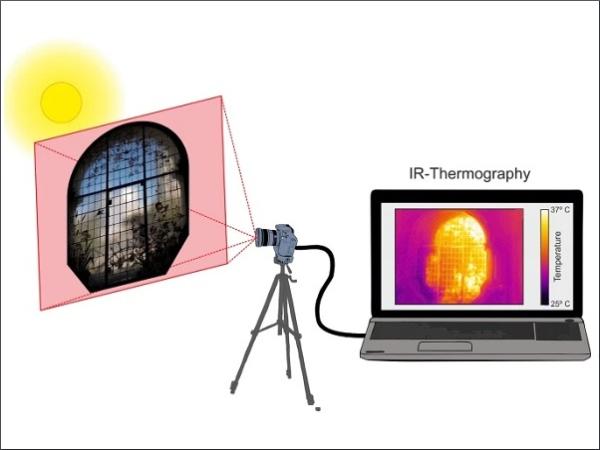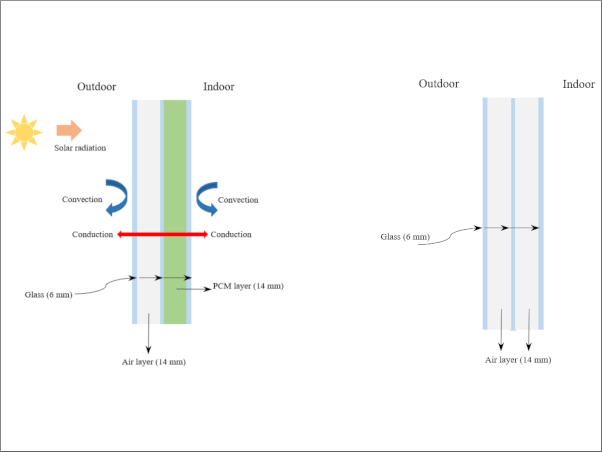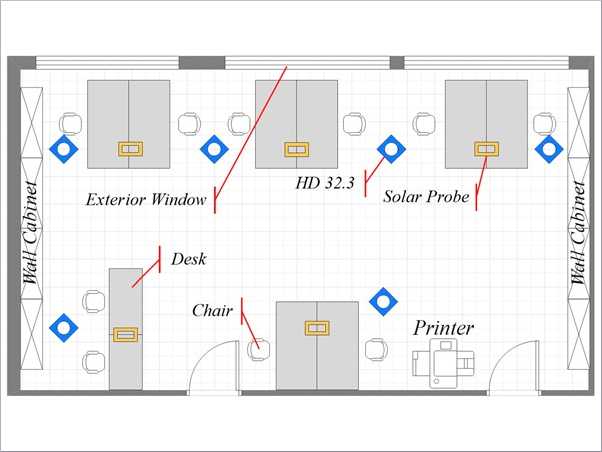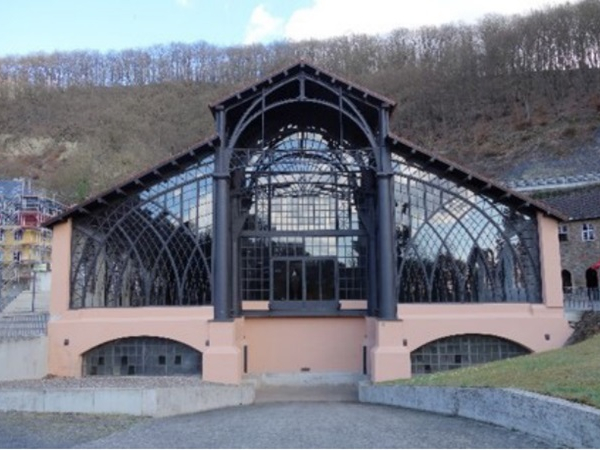Authors: Teresa Palomar, Miguel Silva, Marcia Vilarigues, Isabel Pombo Cardoso & David Giovannacci
Source: Heritage Science volume 7, (2019) - Springer | https://doi.org/10.1186/s40494-019-0325-3
Abstract
This work presents the results of the evaluation of two Art Nouveau glass windows from the Casa-Museu Dr. Anastácio Gonçalves (Lisbon, Portugal) with IR-thermography during the summer solstice. According to the measurements, the surface temperature of glass depended on the outdoor environmental temperature and, mainly, on the direct solar radiation. Colored glasses presented a higher surface temperature due to the absorption of their chromophores at near-IR wavelengths. Enamels and grisailles showed higher surface temperatures than their support glasses due to both their chemical composition and color. The protective glazing, with small slits in one of the window panels, induced a hot-air pocket in its upper part due to the insufficient ventilation.
Introduction
Stained-glass windows are large complex works formed by colored glasses in which the lead cames and the grisaille painting define the contours and shadows. They can also be made of uncolored pieces of glass painted with enamels and grisailles, these are normally denoted as glass panels [1,2,3]. The aim of both glass windows is to illuminate the inner part of the building, such as normal windows; but also to serve as decoration when the light illuminates them. In religious buildings, this latter function is frequently related to an instructive purpose; but in civil buildings, they are decorative elements usually with geometric patterns, symbolic elements, or landscapes. The stained-glass windows protect also the building from the external environmental conditions.
Rain and pollution are the environmental factors that contribute most for the glass alteration [4,5,6,7,8,9,10,11,12]; nevertheless, temperature has also a significant role [13,14,15,16,17]. From the physical point of view, solar radiation can induce the movement of the stained-glass windows due to the dilatation of the different materials [14]. Nevertheless, the main damage due to temperature fluctuations can be observed on surface paints (enamels, grisailles), which can present cracking, flaking, and, eventually, the detachment of the paints from the glass support due to their different dilatation coefficient. This effect has been observed principally on historical bluish enamels [18,19,20].
To map the natural heating of the different materials on stained-glass windows, it is necessary to use infrared (IR) thermography, a portable technique capable of measuring in situ the temperature on different areas and over time. This technique has been applied to evaluate the thermal efficiency of different windows systems [21, 22], as well as, to evaluate glasses with different industrial purposes [23,24,25,26], to research fire endurance of tempered glass [27], to study the mechanical defects and the elastic deformations on glass sheets [28,29,30,31,32], and to analyze the efficiency of solar cells [33, 34]. The application of IR-thermography on historical glasses is scarce [20, 32, 33]; nevertheless, these studies proved to be a useful tool to evaluate the conservation of historical stained-glass windows [35, 36].
The main objective of this research was to assess the natural heating of two Art Nouveau glass windows from the Casa-Museu Dr. Anastácio Gonçalves (Lisbon, Portugal) with IR-thermography for the period of one day during the maximum amplitude of sun radiation (summer solstice) to identify the influence of the environmental temperature, the solar radiation and the protective glazing on the glasses, surface paints and other materials related to the glass windows.
Materials and methods
Stained-glass windows
The Casa-Museu Dr. Anastácio Gonçalves has two glass windows in Art Nouveau style signed by the Societé Artistique de Peinture sur Verre in 1904. One of them is located on the first floor in the Dining room, and the other one is in the Atelier on the second floor (Fig. 1). This latter glass window presents a very poor state of conservation with loss of the bluish and purplish enamels. Unconventional colors were also observed in the lower part of this glass window, which can be probably related to retouching.
Both windows have a protective glazing in their exterior. They are frameless glazing systems that permit to open both windows. The Dining-room panel presents four sheets of protective glazing at ~ 15 cm from the historical window, one in each lateral panel and two more in the central one with a small separation between them to favor the ventilation. The Atelier panel presents a six-sheets protective glazing that coincides with the historical panels. It is situated at less than 2 cm from the historical window due to the presence of architectonical elements. Ventilation slits, with less than 5 mm in some areas, are in between the different protective glasses and between the protective glass and the wall.
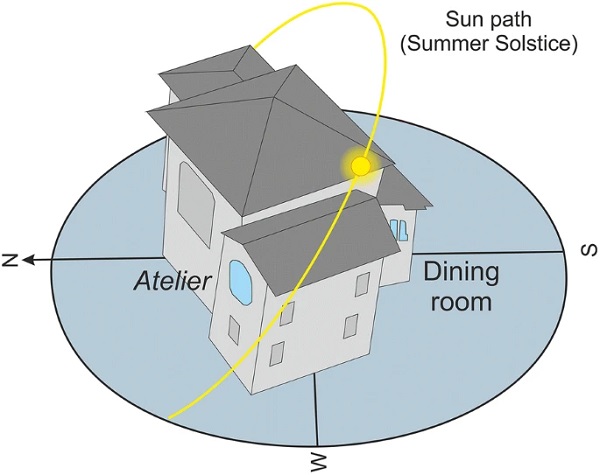
Orientation of glass windows in the Casa-Museu Dr. Anastácio Gonçalves with the sun path during the summer solstice - Full size image
Infrared thermography
The characterization of the surface thermal behavior of the glass windows was carried out with a FLIR T650sc [3,4,5]. The system used for the study comprises a detection device, and electronic and computing instrumentation for monitoring. The detection system is constituted of an infrared camera of thermography (20° × 15°/0.3 m Field of view, 1.1 mRad spatial resolution, 50 mK at 30 °C Thermal sensitivity, 7.5 to 13 μm Spectral range). Finally, an analysis module completes the system. The measurements can be done in the range of temperature − 40 °C to 120 °C, with a thermal resolution < 0.02 at 30 °C. For both windows, a daily monitoring (3 IR images every 5 min) was carried out. The heat sources were environmental temperature and sunlight.
Results and discussion
Impact of the environmental temperature
The study was done during the summer solstice (June 2017), with the longest and hottest days of the year. The presence of a hot wave during the first days of the monitoring produced higher environmental temperatures on the Dining room glass window and slightly lower temperatures during the analyses of the Atelier panel (Fig. 2a, b). Nevertheless, it was detected that the environmental temperature in the shadow rose up to 30 °C around noon and fell to ~ 20 °C during the hours previous to the sunrise (Fig. 2a, b).
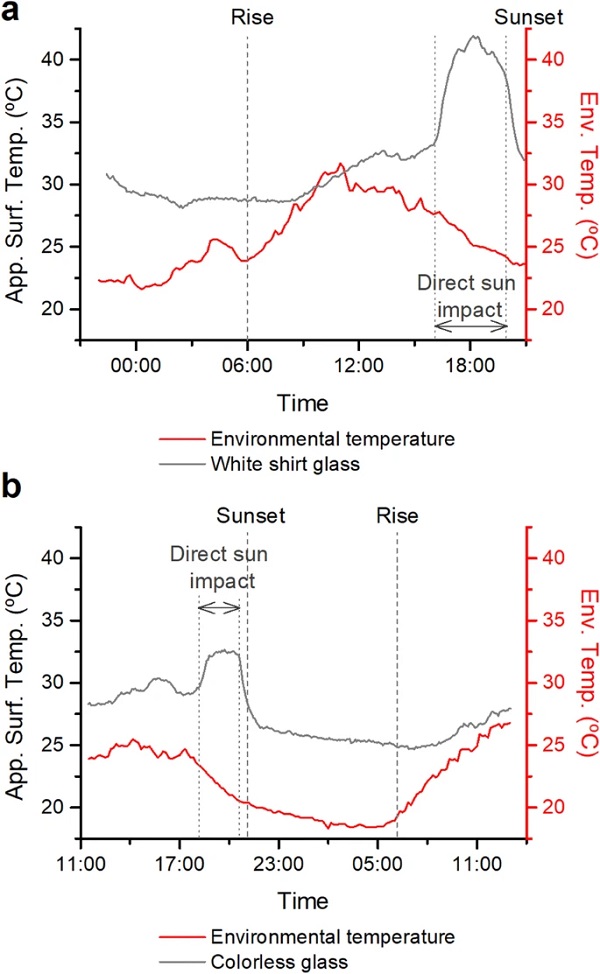
The comparison between the temperature inside and outside the building showed that, in general, the apparent surface temperature measured on the indoor glass surface was higher than the external environmental temperature due to the greenhouse effect produced inside the building. Nevertheless, both temperatures were related because they presented a similar heating and cooling behavior (Fig. 2a, b).
During the morning, when the sun did not impact directly on the panels, it was observed a slow increase of the temperature due to the conduction of environmental heat through the glasses. This heat flow depends on the temperature gradient, as well as on the own characteristics of the glass [37].
The colorless glass in the Dining room panel rose up to 32 °C (Fig. 2a), just due to the influence of the external environmental temperature. In the case of the Atelier panel, the temperature detected on the colorless glasses in the middle of the panel rose up to 30 °C (Fig. 2b).
During the night, it was observed the gradual fall of the apparent surface glass temperature (Fig. 2a, b). The minimum temperature was detected around the sunrise. The temperature of the colorless glass in the Dining room panel decreased to ~ 28 °C and in the Atelier panel to ~ 25 °C.
Impact of the solar radiation
The direct solar radiation was the most important factor in the temperature of the glass windows. Nevertheless, it experienced slight variations due to the shadow produced by surrounding trees and buildings (Fig. 2a, b). The Dining room stained-glass window had more than 5 h of direct solar radiation, and the Atelier just 4 h. This different duration of sun exposure is due to the orientation of the windows in the building (Fig. 1).
In the colorless glass of the Dining room window, it was registered an increase of ~ 2 °C each 20 min during the first hour of direct solar radiation (Fig. 3a). The difference between the temperature just before the radiation and the maximum during the radiation was around 10 °C. The contrary behavior was observed with the loss of solar radiation; it was detected a maximum decrease of 3.6 °C in 20 min and a total decrease of 9 °C (Fig. 2a).
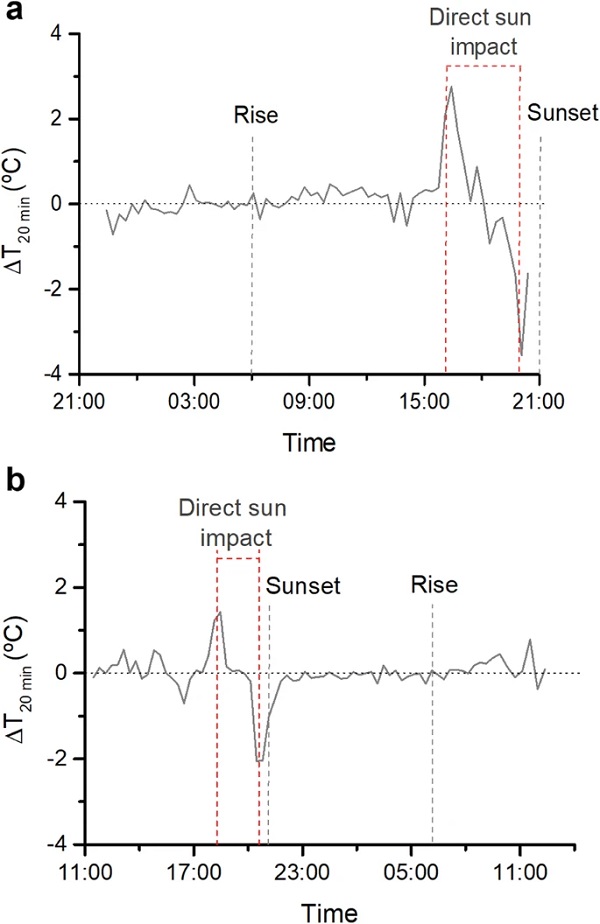
In the Atelier panel, the impact of the solar radiation was lower than in the Dining room window because of the panel orientation, the shorter duration of exposure (4 h), the lower greenhouse effect in the room due to their dimensions and, possibly, the lower outdoor environmental temperature. It was detected a progressive increase of ~ 1.3 °C each 20 min during the first 40 min of direct solar radiation (Fig. 3b) and a total increase of 3 °C (Fig. 2b). After the loss of the solar radiation, the decrease was higher because it coincided with the sunset and the corresponding decrease of temperature (Fig. 3b). It was observed a decrease of ~ 2 °C each 20 min during the hour after the sunset and a maximum of 5 °C of variation.
These thermal variations were higher than those observed in two monitored French churches (the Sainte Urbain Basilica in Troyes and the Saint Chapelle in Paris) [38]; nevertheless, the rate of the temperature increase/decrease was slower due to the protective glazing and, probably, to the shadowing of the windows.
Most of the solar radiation ranges between 0.01 and 4 µm, in the ultraviolet (UV), visible and near-infrared (near-IR) regions of the electromagnetic spectrum. Around 8% of solar radiation falls in the UV region (0.01–0.4 µm), ~ 40% contains the radiation of the visible region (0.4–0.7 µm) and ~ 52% of the radiation falls in the near-IR (0.7–4 µm) [39]. The transmittance of glasses to radiations from 0.3 µm up to 2.8 µm is around 0.9 and the reflection is around 0.07, which means that they are practically transparent to the radiation [40, 41]. Nevertheless, the glass transmittance for radiations with wavelengths between 2.5 and 4.0 µm decreases to ~ 0.4, and for wavelengths higher than 5.0 µm the transmittance is almost null [40, 42].
According to this fact, glasses are transparent to most of the solar radiation (visible and near-IR regions) absorbing the mid-wave and long-wave IR radiation. The short-wave IR radiation can be absorbed by the materials inside the room, being converted into heat. The material’s surface reacts to this rise in temperature by emitting long-wave heat radiation. The radiant heat emitted by the materials with wavelengths higher than 4.0 µm (long-wave IR radiation) is mostly absorbed and some reflected by the glasses, but none is transmitted to the outside. This fact increases the temperature of the indoor glass surface, which will be re-radiated inwards increasing, even more, the room temperature. This phenomenon is the greenhouse effect [41].
Considering the complete panel, the stained-glass window in the Dining room showed a similar surface temperature during the night, independently of the glass color (Fig. 4a, b), instead of a vertical cold line in the bottom panel and a slight temperature increase in the upper panel produced by the protective glazing (“Impact of protective glazing” section). During the morning without the direct solar radiation, the surface temperature of the glasses was similar but some colors presented a slightly higher temperature (> 0.5 °C) (Fig. 4c). During the exposition to the solar radiation, the surface temperatures increase their value ~ 10 °C, depending on their color, with a maximum value of 48 °C (Fig. 4d). This phenomenon will be deeply discussed in “Impact on colored glasses” section.
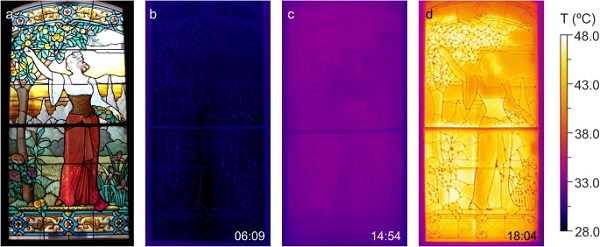
Similar behavior was observed on the Atelier panel. During the night, the temperature of the panel was homogenous (Fig. 5b); but, during the day, the surface paints presented a higher temperature even without the solar radiation (Fig. 5c, d). This phenomenon will be further discussed in “Impact of surface paints” section.

Impact on colored glasses
On the Dining room stained-glass window, it was possible to observe that some glasses increased more their surface temperature during the day (Fig. 4b, c). This phenomenon could be produced by the thickness of the glass and/or their different color.
Regarding the thickness, the conduction of the heat from outside is faster in thin glasses due to the less distance between both surfaces. In the Dining room panel, some glasses (the hydrangeas on the left side of the panel and the irises on the right one) were acid etched to create different hues and volumes; but it was not detected local heating in the thinner areas. Furthermore, glaziers normally use glasses with similar thickness on stained-glass windows to better secure them with the lead came [43]. Thus, the different thermal behaviors were not correlated to the glass thickness.
Regarding the color of the glass, the chromophores can modify the glass heating by absorbing some of the solar energy and diminishing energy transmission [44]. It was observed that those areas with higher temperature were, principally, the greenish glasses from the vegetation (Fig. 4b, c). It is not easy to compare the glasses from different areas of the window because of their different exposure to natural solar radiation. Nevertheless, the analysis of a local area with different colored glasses (Fig. 6a) confirmed that the greenish glasses presented a slightly higher temperature than the orange ones during the period of solar radiation (Fig. 6b). This temperature variation is higher than the incertitude of the measurement. It was also observed that the colorless glasses were the coldest ones.
This phenomenon is related to the chromophore absorbance at near-IR wavelengths [42, 45]. The colorless glasses do not present chromophores or they are chemically compensating each other, and therefore they did not absorb in the near IR-region. Nevertheless, the most common chromophores on greenish glasses were iron and copper ions [46]. The Fe2+-ions produce two absorptions in the infrared region at 1100 (5T2 → 5E) and 2100 nm (distortion splitting) together with an absorption band at 440 nm (visible region) [47, 48]; and the Cu2+-ions have the electronic transition 2E → 2T2 at 790 nm with a significant deformation due to the Jahn–Teller effect, the tail of this wide single band enters into the IR-region [42, 47, 48]. The absorption in this region favored the increase of the heat capacity of the glass, increasing its temperature [49]. Blue, red and purple glasses could have also higher temperatures due to a higher absorption coefficient [14, 15].
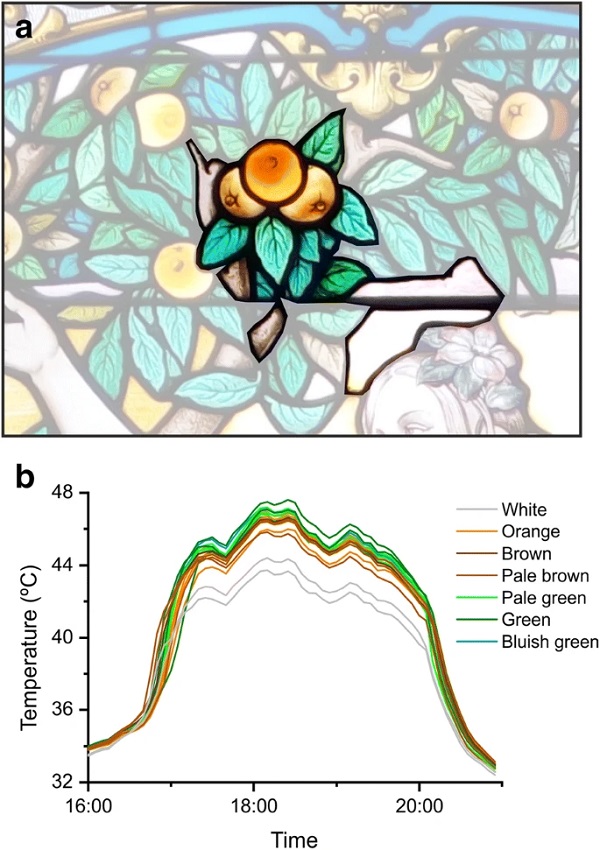
This phenomenon was mostly observed during the impact of the solar radiation (Fig. 4d); however, it was also detected during the morning, without the solar radiation (Fig. 4b), due to the indirect lighting produced by the diffuse sky radiation and the reflection of the solar radiation on the building’s façades [50, 51].
Impact of surface paints
The inner surface of both windows was painted with grisailles and enamels. A grisaille is a dark paint applied to draw the contours and details of the figures, and to produce the effect of shades and volumes. The grisailles are made by powdering a highly fusible glass, usually lead glass, with pigments such as iron or copper oxides, but it can also contain tin, and/or manganese oxides. During firing, the grains of fusible glass melt and fix the pigment grains onto the glass surface [52,53,54,55]. On the other hand, an enamel is a brightly colored paint formed by a highly fusible glass, a lead glass with/without borax, with a small amount of pigment. The powdery enamel is applied onto the glass pane with a brush and then fired. The result is a thin homogeneous layer of glass of bright color on the glass surface [52, 56].
In the glass windows from the Casa-Museu Dr. Anastácio Gonçalves, the areas painted with enamels and grisailles increased more their apparent surface temperature than in colorless glasses (Fig. 7a, b). During the morning (without solar radiation), the difference between the surface paints and the support glass was ~ 1 °C, but the solar radiation increased this difference in ~ 3 °C, in addition to the increase of 10 °C produced by the impact of the solar radiation on the glass support (“Impact of the solar radiation” section).
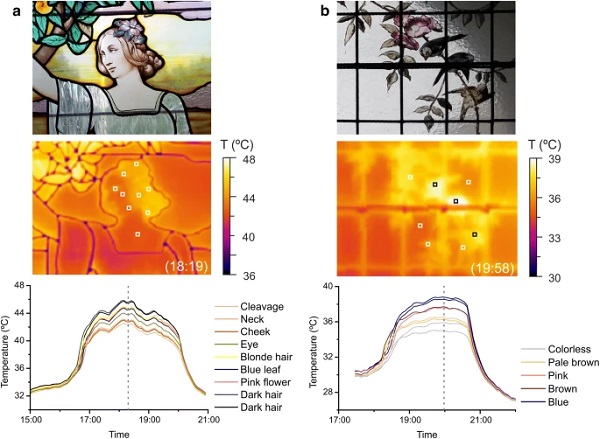
Soda-lime silicate glasses have a higher specific heat than high-lead glasses [42, 57]. This means that, in the same conditions, the support glass, a soda-lime silicate glass, need more energy to raise one degree Celsius than the surface paints, prepared with high-lead glasses. In other words, for the same energy, the surface paints should increase more their temperature than the support glass, as it was observed. In addition, the thermal conductivity of borosilicate flint glasses and the heavy flint glasses (surface paints) is slightly lower than soda-lime silicates (support glass) (Table 1) [58], which favors accumulation of heat in the enamels and grisailles instead of their transmission to the support glass (Fig. 7a, b).
Table 1 Thermal properties of different building materials, anormal emissivity of glass at 50 °C. - Full size table
It was also observed a direct relationship between the color of the grisailles and enamels and their apparent surface temperature (Fig. 7a, b), in the same way than colored glasses (“Impact on colored glasses” section). It was observed that clear colors such as the shadows made with grisaille (Fig. 7a) or the clear enamels (Fig. 7b) presented a similar behavior to colorless support glasses. However, brilliant colored enamels experienced a higher increase of temperature due to the absorption of the IR-radiation; and, black and very dark colors, such as grisailles, were the areas with the highest increase of temperature (Fig. 7a, b). These latter materials normally are rough dark paints with iron oxides in their composition. This favors an intense absorption of the thermal radiation, increasing their temperature [36].
The different surface temperature observed on the paint and the support glass could promote the thermal incompatibility in the Atelier panel, mainly on bluish and purplish enamels, favoring the formation of fissures and the mass loss [59].
Impact of protective glazing
Protective glazing is formed by float glasses (soda-lime silicate glass) with a high resistance to environmental alteration [11, 12, 60], which creates a physical barrier between the historical stained-glass windows and the environmental weather (rain, wind, pollution…). The protective glazing also decreases the amplitude of the temperature along the day, which carries the reduction of the thermal shocks, the risk of condensation, and the dilatation of the window materials [38, 61,62,63,64,65,66]. Protective glazing is widely accepted as a preventive conservation method for stained-glass windows, but a lot of doubts still exist, in particular, if the microclimate in the interspace enhances the thermo-hygrometric cycles and/or the growth of micro-organisms [62, 65, 67].
An external ventilation permits to enter the humidity from the outdoor environment, which increase the humidity on the surface of the historic stained-glass windows, in contrast to the significant reduction of the humidity in the air chamber in glazing with internal ventilation [62,63,64,65,66]. Nevertheless, the efficiency of the ventilation depends on the size of the space between the original window and the protective glazing and, principally, on the size of the ventilation slits [64].
Both windows in the Casa-Museu Dr. Anastácio Gonçalves presents protective glazing. In the Dining room window, the central panel has two sheets with a small separation between them to promote ventilation. This separation created an area of low temperature during the night because of the environmental air flow entrance through the slit creating complex recirculating flows in the bottom part (Fig. 4b) [68]. During the day, this area presented a similar temperature than the nearby areas (Fig. 4c), but the most important variation observed was due to the impact of the solar radiation, when a vertical line with higher temperatures (increases of ~ 3 °C) was detected because of the direct exposure of solar radiation on the historical window (Fig. 4d). This vertical line shifted progressively to the left as the sun moved to west (Fig. 8a, b). Minima detected on Fig. 8b were due to the metallic elements of the window (“Impact on other materials” section).
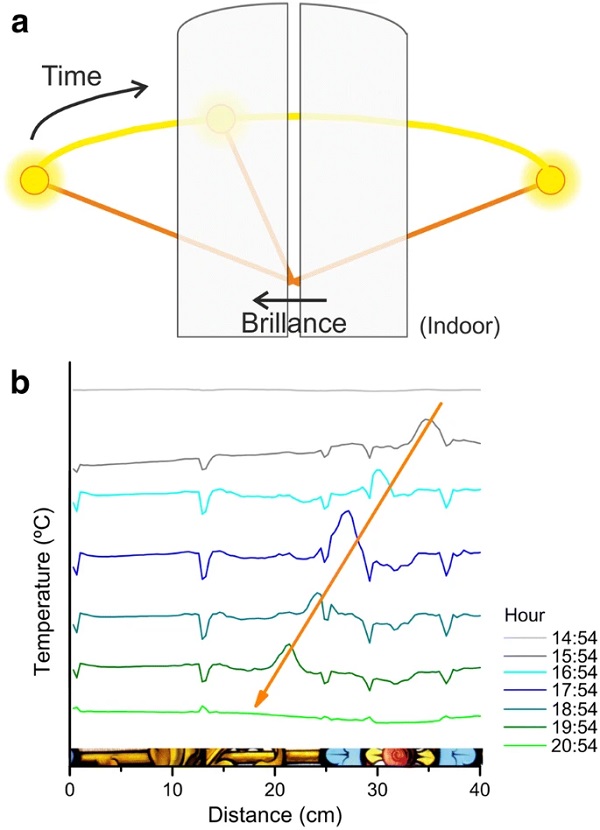
A completely different case was observed on the Atelier window. The protective glazing was placed at less than 3 cm to the historical panel, due to the architectonical elements, and with very small slits of ventilation. This protective glazing almost airtight favored that the hot air was trapped in the upper part of the window panel increasing the temperature of this part of the panel (Fig. 5b). This effect was observed throughout the day, with the thermal variations of up to 3 °C between the upper and the lower part of the window (Fig. 5b).
Impact on other materials
Glasses and their surface paints (enamels and grisailles) were the elements on the stained-glass windows with the greatest thermal variations; however, there are other materials that are also affected by the diary thermal variation such as the lead cames, the tin–lead welds, the steel supporting rods, the wood frame, and even the walls and other nearby objects.
Regarding the metallic elements, it was observed that during the solar impact, the lead cames increased their temperature ~ 8 °C (Fig. 9a), with a similar behavior than the colorless glass (Fig. 2a). This behavior can be related to the heat conduction on the lead, together with the reflection of the radiation on the metallic surface, which can affect the measurements [40]. During the night, the lead cames decreased their temperature, but they remained hotter than glass (~ 1 °C) until the increase of the outdoor environmental temperature (around 9:00 h). This behavior can be related to a slow decrease of the lead temperature during the night.

Regarding the tin–lead welds on the lead cames, they experienced a small increase of temperature during the solar radiation (~ 4 °C) because of their higher distance to the glasses. The welds just increased their temperature due to the thermal conduction from the lead cames or the heating due to the indoor temperature. During the night, they presented a higher temperature than lead (Fig. 9a), probably due to a slower process of cooling. This behavior can be related to the thermal conductivity of different materials (Table 1). More conductive elements see their temperature decrease more quickly than less conductive elements.
The wood frames and the walls also experienced a variation on their surface temperature due to the impact of the solar radiation (Fig. 9b). In this case, the highest values were obtained at the end of the period of direct solar radiation, when the greenhouse effect inside the room was maximum. Both wooden frame and wall presented a small increase of temperature because of the lower thermal conductivity of the wood (Table 1); however, the screw in the wood frame increased further its surface temperature because of the room’s temperature due to its higher thermal conductivity (Table 1).
Conclusions
Two Art Nouveau glass windows from the Casa-Museu Dr. Anastácio Gonçalves were characterized with IR-thermography within the period of one day during the summer solstice. It was evaluated the influence of the environmental temperature, the solar radiation and the protective glazing on the glasses, surface paints and other materials related to the glass windows.
The outdoor temperature favored the thermal flow through the glass, increasing its indoor surface temperature. Nevertheless, the most important factor on the temperature of the glass windows was the direct solar radiation, which could increase the surface temperature up to 40 °C in the Dining room glass window and 35 °C in the Atelier panel. The different behavior depended on the orientation of the window, the dimension of the room and, probably, the outdoor temperature. Regarding the colored glasses, the green areas showed the highest surface temperature because of the chromophores (iron and copper ions) in the near IR-region; in contrast to colorless glasses, which presented the lowest temperatures due to the absence of chromophores. Concerning the enamels and grisailles, they increased their surface temperature in comparison with the glass support due to the lower specific heat and thermal conductivity of the high-lead glasses and borosilicate glasses.
Both windows have a protective glazing. In the Dining room window, the separation between the protective glass sheets favored the environmental air flow entrance promoting the presence of an area with a higher amplitude of the temperature throughout the day. In the Atelier, the short distance between the original window and the protective glazing, and the small size of the ventilation slits favored the formation of a hot area in the upper part of the window panel increasing the temperature of this part in around 3 °C. To avoid the thermal alteration of the stained-glass window, it is recommended to install a protective glazing with good ventilation (mainly in the upper part where the hot-air pocket is trapped) and to frequently ventilate the space in between the historical window and the protective glazing.
The metallic elements (lead cames, tin–lead welds) of the glass windows showed a similar behavior than the colorless glass but their thermal variation depended on the thermal properties of each material. The wood frames and the walls also experienced a thermal variation, but it was directly related to the greenhouse effect inside the room.
Availability of data and materials
The datasets used and/or analyzed during the current study are available from the corresponding author upon request.
References
Acknowledgements
The authors thank Dr. T. Marques and Dr. A. Mântua (Casa-Museu Dr. Anastácio Gonçalves, Lisbon, Portugal) for the facilities provided to accomplish this research, and Dr. A. Moure and Dr. D. G. Calatayud (ICV-CSIC, Spain) for their useful help in the interpretation of the data.
Funding
This work has been funded collectively by the Access to Research Infrastructures activity in the Horizon 2020 Programme of the EU (IPERION CH Grant Agreement No. 654028), the Fundação para a Ciência e Tecnologia of Portugal (Project Ref. UID/EAT/00729/2019) and Fundación General CSIC of Spain (ComFuturo Programme). We also acknowledge support of the publication fee by the CSIC Open Access Publication Support Initiative through its Unit of Information Resources for Research (URICI).
Author information
Authors and Affiliations
Instituto de Cerámica y Vidrio, Consejo Superior de Investigaciones Científicas (ICV-CSIC), c/Kelsen 5, Campus de Cantoblanco, 28049, Madrid, Spain - Teresa Palomar
Unidade de Investigação VICARTE “Vidro e Cerâmica para as Artes”, Universidade Nova de Lisboa, Campus de Caparica, FCT-UNL, Quinta da Torre, 2829-516, Caparica, Portugal - Teresa Palomar & Marcia Vilarigues
Dept. Conservation and Restoration, Universidade Nova de Lisboa, Campus de Caparica, FCT-UNL, Quinta da Torre, 2829-516, Caparica, Portugal - Miguel Silva, Marcia Vilarigues & Isabel Pombo Cardoso
LAQV-REQUIMTE, Universidade Nova de Lisboa, Campus de Caparica, FCT-UNL, Quinta da Torre, 2829-516, Caparica, Portugal - Isabel Pombo Cardoso
Laboratoire de Recherche des Monuments Historiques, CRC-LRMH, CNRS USR 3224, Champs-sur-Marne, France - David Giovannacci
Contributions
TP designed the study; DG made the thermographic analyses; TP, MS, MV and IPC supervised the analyses in the museum; TP interpreted the results, prepared the original draft and submitted the manuscript. All authors read and approved the final manuscript.
Corresponding author
Correspondence to Teresa Palomar.
Ethics declarations
Competing interests
The authors declare that they have no competing interests.

